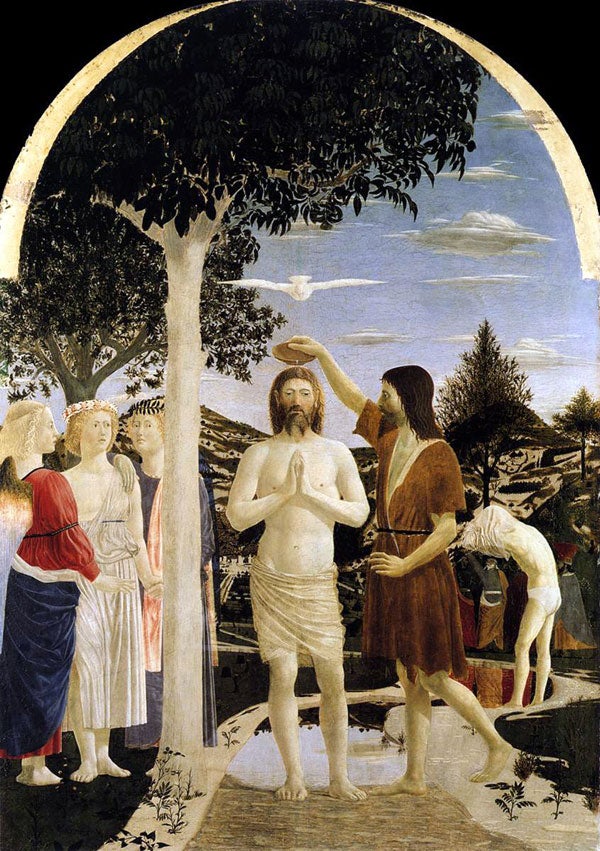Great Works: The Baptism of Christ (1448-1450), Piero della Francesca
National Gallery, London

The elephant in the room is a cliché, going on proverb. It refers to something that is enormous, obvious, unignorable – but that manages somehow to be ignored and overlooked. Deliberately overlooked? Carelessly? The phrase can imply either, or perhaps a bit of both. But whichever, the overlooking is culpable. The enormous, obvious, unnoticed thing should have been noticed. There are circumstances, though, when an elephant in a room is a welcome guest. Sometimes it is better for large and prominent things to stay overlooked. It's not just a matter of turning a blind eye to something unpleasant. There are situations where a big unnoticed thing is a positive benefit. It happens in art.
Piero della Francesca's The Baptism of Christ is a timely painting. Christians have long celebrated the baptism of Jesus by St John the Baptist in Jordan River at this time of year. Piero's arched image was originally part of an altarpiece in a church in Sansepolcro, his hometown in Tuscany. It has a characteristically rich and complex patterning. There is the ruling central vertical – the dove of the Holy Spirit, hovering wings-out and head-on, placed exactly above the trickle of baptismal water, which is exactly aligned with Jesus's divided beard, praying hands, navel. It's a vertical supported by the straight tree trunk next to him, and the overlapping, upstanding trio of angels. There is the contrast of Jesus's full-face against St John's perfect profile. There is the Umbrian hillside behind, with its veined landscape of greenery and earth. There is the sky with its streaked clouds, echoing the horizontal dove. There is the bending man taking his shirt off, making a "window" through which the more distant figures appear.
There are all these visual effects, and more, and they each have symbolical interpretations. But if you ask what is the single largest thing in the picture, it's something else: the foliage of the tree. That's the elephant in this room. Big as it is, we don't really notice it, as it spreads over the scene below, joining in with the curving frame (and the tree behind it) to make a protective arch.
Of course, art history has noticed it. It has identified it, from its beautifully painted leaves, as a walnut. It has explained that the walnut has a symbolic role in the sacred history of Sansepolcro. The walnut is also a symbol of Christ's crucifixion. But what art history won't tell you is the tree's place in the picture – or rather, its place in the viewer's attention. And the point is not that you should be paying more attention to this interesting tree. No. You we're probably paying it exactly the right amount before it was mentioned. Art history can be useful. Art criticism can bring things alive. But there really are artistic effects that are destroyed by being pointed out. Not being noticed is of their essence. This is one of them.
The walnut tree has a guardian power here. It's probably the dominant effect in the whole picture. But it draws its strength from being subliminal, peripheral. It works as an undercurrent, a corner-of-eye thing. Once it has been announced or (worse) analysed, it's dispelled. It's to do with the relative heights of Jesus and the picture itself, and the way the dove creates a "roof", a stop, so that our attention doesn't rise further. But the more you try how to understand how Piero causes this large thing to become largely invisible, the more you lose its force. The elephant is out. And I'm afraid the damage here has been done.
Join our commenting forum
Join thought-provoking conversations, follow other Independent readers and see their replies
Comments